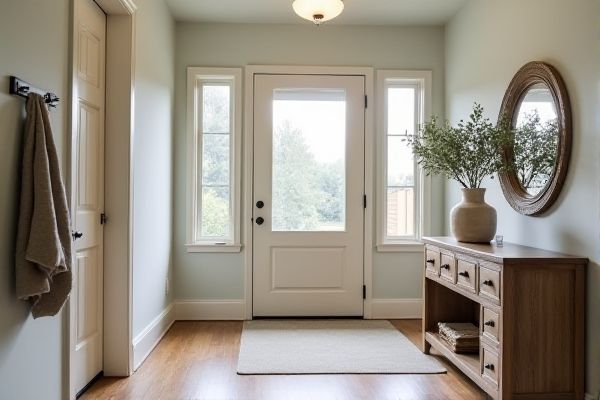
Entryway tables and foyer tables both serve as stylish and functional pieces for welcoming guests, but entryway tables are typically narrower and designed for smaller spaces, while foyer tables tend to be larger and more decorative to make a strong first impression. Discover how to choose the perfect table for Your home by exploring the key differences and benefits outlined in the rest of this article.
Table of Comparison
| Feature | Entryway Table | Foyer Table |
|---|---|---|
| Location | Placed in the entryway, a small passage area before entering a home | Positioned in the foyer, a larger formal entrance space |
| Purpose | Functional, for holding keys, mail, and small items | Decorative and functional, often showcasing decor, flowers, or lighting |
| Size | Generally smaller and narrow to fit tight spaces | Larger, more substantial tables to suit spacious foyers |
| Design | Simple, minimalistic for compact utility | Elegant, often ornate to make a statement |
| Storage | Often includes drawers or shelves for organization | May have storage but prioritizes aesthetics |
Understanding Entryway Table and Foyer Table
Entryway tables and foyer tables serve as functional and decorative furniture pieces designed to enhance the entrance area of a home. An entryway table is typically smaller, narrow, and positioned in hallways or entryways to hold keys, mail, and small decor items, optimizing limited space. Foyer tables tend to be larger and more ornamental, placed in spacious entry rooms to create a welcoming ambiance with room for lighting, mirrors, and elaborate accessories.
Key Differences Between Entryway Tables and Foyer Tables
Entryway tables are typically narrower and designed for compact spaces near exterior doors, emphasizing functionality such as holding keys and mail. Foyer tables often have a more decorative purpose and larger surface area, serving as a focal point for welcoming guests in more spacious entry halls. The key differences lie in size, location, and dual focus on practicality versus aesthetic appeal in home entry designs.
Purpose and Functionality in Home Design
Entryway tables serve as versatile surfaces for storing keys, mail, and everyday essentials, enhancing organization near the main door. Foyer tables are designed to create an inviting first impression, often adorned with decorative items like vases or artwork to establish style and ambiance. Both types optimize space usage while balancing practicality and aesthetic appeal in home design.
Size and Space Considerations
Entryway tables tend to be narrower and more compact, making them ideal for smaller spaces or narrow hallways where floor space is limited. Foyer tables are usually larger and more robust, designed to serve as a central piece in a wider foyer area that can accommodate additional decor or storage. When choosing between the two, consider your entryway's size and layout to ensure your table fits comfortably without crowding your space.
Style Options for Entryway vs Foyer Tables
Entryway tables feature versatile style options ranging from rustic farmhouse designs to sleek, modern aesthetics, making them adaptable to various home decors. Foyer tables often emphasize elegance with intricate details, ornate legs, and premium materials like marble or glass to create a grand first impression. Both table types offer customizable finishes and storage solutions, but foyer tables typically prioritize decorative appeal over utilitarian function.
Material Choices Comparison
Entryway tables often feature durable materials like solid wood, metal, or engineered wood for high-traffic areas, ensuring longevity and scratch resistance. Foyer tables tend to incorporate more decorative elements with materials such as marble tops, glass, and ornate metalwork to create a stylish first impression. Comparing material choices, entryway tables emphasize practicality and durability, while foyer tables prioritize aesthetic appeal and intricate craftsmanship.
Storage and Practicality Features
Entryway tables typically offer more versatile storage options such as drawers, shelves, and compartments designed to hold keys, mail, and everyday essentials efficiently. Foyer tables often prioritize aesthetic appeal with limited or no storage but may include decorative trays or baskets for small items. Your choice should consider whether you need functional storage solutions or primarily a stylish surface to complement your home's entrance.
Placement Tips for Entryway and Foyer Tables
Entryway tables are best placed against a wall directly opposite or adjacent to the front door to provide a convenient drop zone for keys and mail, while foyer tables often occupy a more centralized or decorative position in a larger entrance space. Your table's placement should complement traffic flow, ensuring it doesn't obstruct pathways while enhancing the area's aesthetic appeal with plants, mirrors, or lighting. Opt for narrow, functional designs in tight entryways, and choose statement pieces in spacious foyers to create a welcoming atmosphere.
Decor Ideas for Both Table Types
Entryway tables often feature slim profiles and storage options like drawers or shelves, making them ideal for organizing keys and mail while adding decorative elements such as vases or picture frames. Foyer tables typically serve as elegant statement pieces with intricate designs or bold materials, perfect for showcasing large mirrors, art, or floral arrangements that enhance your home's first impression. Combining functional decor like baskets for shoes with decorative accents like sculptures can elevate both entryway and foyer tables to create a welcoming, stylish space.
Choosing the Right Table for Your Space
Entryway tables typically offer slim designs ideal for narrow corridors, while foyer tables often feature more ornate styles suited for larger, open spaces. Your choice depends on the available space and functional needs, such as storage or decorative display. Selecting the right table enhances both the style and practicality of your entry area.
 homyna.com
homyna.com